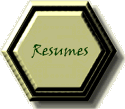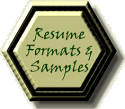Cover Letters

Why send Cover Letters?
Every resume should be accompanied by a cover letter. This is common courtesy. It explains to the receiver why you have sent them your resume. True, all cover letters are not read. Some are even thrown away. However, better that than that your RESUME be thrown away which is often the case if it is not accompanied by a cover letter. As one recruiter put it, “If a candidate doesn’t have the courtesy to tell me what they are applying for and why, I don’t have the time to consider their resume”.
Be sure to use the same font style, font size, and paper that you use for your resume. Make it readable. The cover letter is a marketing tool in your sales campaign to sell yourself. Use it as a vehicle to convey your professionalism. Target it to the client’s needs. Make it simple, direct and specific.
A cover letter serves as a sample of a job candidate’s communication skills, therefore a well written one can serve as another reason to hire you, while a poorly written or missing one can be justification not to consider you for a position.
Use your cover letter as a chance to show your prospective employer what is in it for THEM. Why should they hire you? What can you do for them? Why do you think that you are a good match for this job? How can you solve their problems? This is far more important to a prospective employer than what you have done for past employers.
A cover letter is a chance to sell yourself to a prospective employer and to interest them in YOU. It can be as critical to your success as a good resume. In fact, some job search gurus consider it more important.
What is a Cover Letter?
A cover letter is a business letter. The content has three main parts, an introduction, a body, and a conclusion (uh-oh, sounds like English class, doesn't it?). Cover letters follow the same style and formatting principles of any professional business letter.
Include the following: your address, date, company address, salutation, introduction, body, conclusion, formal close.
Include your address so that the recipient knows how to contact you. Include the date so that everyone is clear as to when this was written. Include the company address and the recipient’s title and department so that they understand you are addressing them. All of this follows professional letter writing protocol. To omit any of these items is to leave a less than professional impression in the recipient’s mind.
Salutation
Reference the posting number and position title
Re: Position 123456789 Monster.com, Business Development Professional
Avoid the use of To Whom It May Concern as a salutation. This is a quick way to ensure your letter and resume end up in the circular file. Use a name wherever possible. If you don’t have a name and can’t track one down, use the title or department title as shown in the examples.
Dear Mr. Smith:
Dear Marketing Director: OR Marketing Director:
Dear Marketing Department: OR Marketing Department:
If you are responding to a posting and can not locate a department or title to direct your letter to, it is permissible to reference the posting and skip the salutation. (Note: treat this option as a last resort).
Content - The Introduction
Your letter should include an introduction, a body, and a conclusion. The introduction introduces you and gives a brief explanation of your reason for applying for the position.
I am very interested on working for your company. As a trainer for ABC Company, I am currently facilitating employee orientation and technical training classes, similar to those in your job description. The posting of August 4, 2002 on Monster.com, for a Training Specialist position with XYZ Company is an excellent match with my qualifications.
Your introduction should include the reason you are writing this letter. Example:
Per your posting of August 4, 2002 on Monster.com , please accept my resume in application for your Training Specialist position with XYZ Company.
If you have a referral name, be sure to indicate it in your introduction.
Bill Brown suggested I write to you directly. . . . . .
Content - The Body
The body should include three bullet points or paragraphs which explain key accomplishments pertinent to the position for which you are applying.
Cover Letter Sample #1 - bullets
An increasingly popular style of cover letter is the “T” letter (or "Q" letter). The body of the “T” letter matches your qualifications with the requirements given in the job posting, using a column format to accomplish this comparison.
Cover Letter Sample #2 - T-letter
Finally, here is a third letter, stating the same information as the other two, but in a completely different format.
Cover Letter Sample #3 - paragraphs
The T-letter format is especially effective in response to job postings, where the bullet or paragraph formats can be very effective when sending letters regarding jobs heard about through network contacts or for which no posted job requirements are available.
Content - The Conclusion
The conclusion should indicate how you will follow-through. Let the employer know where you can be reached, but don't wait for them to follow up, rather assume responsibility yourself for following up with them. This followup is so important to your chances of success that you will find an entire page of this site devoted to it.
I look forward to discussing how my background and training might contribute to XYZ Company’s ongoing success. I can be reached at (555) 555-5555, and will follow up with you next week. Thank you for taking the time to review my qualifications.
Close
Use “Sincerely” for the closing. It’s professional enough and formal enough to avoid the potential problems of other choices. Be sure to allow space for your signature between "Sincerely,” and your typewritten name.
Electronic Cover Letters
Electronic cover letters will be briefer than hard copy letters as the date, to, and from information are given in the e-mail header. You will still want to give most of the introduction, body and conclusion information in your e-mail.
For a resume submitted electronically as e-mail text, you can omit the objective, including it as part of the introductory paragraph instead.
See Resume Tips for information on submitting resumes via e-mail.
Summary
Address your letter to someone specific, by title if no name is available. Example: Hiring Manager, Marketing Director, Sales Manager, Operations Manager, etc. Avoid using "To Whom It May Concern" or "Dear Sir/Madam:".
Tailor it to the position. What does this employer need to know about YOU, that sets you apart from all of the other candidates. Highlight pertinent skills, accomplishments, and results, matching them to the job description. This is not about you, so avoid dwelling on your needs, instead address theirs. You can have that discussion when you receive a job offer!
Be enthusiastic, interested and professional.
Be specific about the position and how your skills, background, and abilities relate to that position.
Personalize your letter. Set yourself apart, show how YOU are unique.
Good luck!





